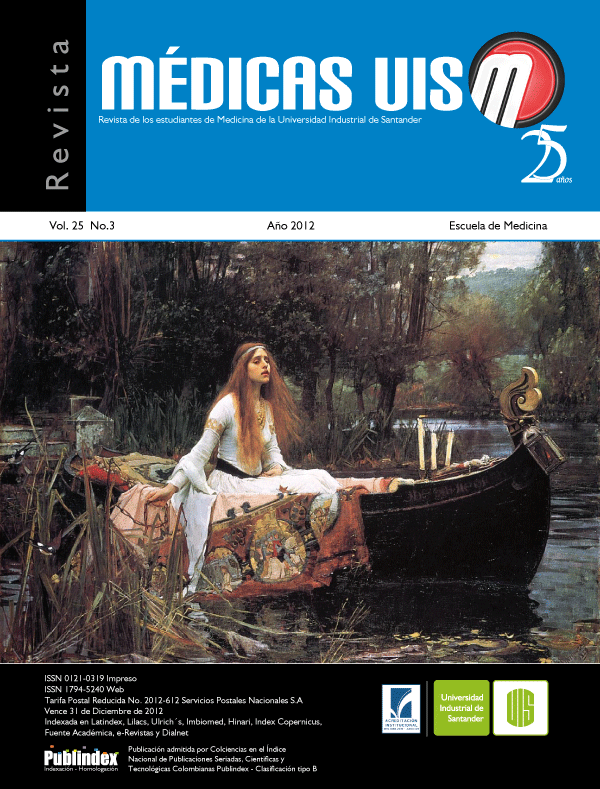Abstract
Introduction: the characteristics of the heart in young judocas have hardly been studied. Therefore, the objective was to know the morphological and functional cardiovascular adaptations in judo girls. Materials and methods: prospective cross-sectional study in 12 judogirls belonging to the school sports “Hector Ruiz”, from Santa Clara, Cuba. Data were collected between january to march 2011. Was performed an echocardiogram and electrocardiogram to morphological and functional evaluation of the heart. Results: mean age was 15 ± 1.34 years and the sport history of 6.8 ± 1.94 years. The left ventricular end-diastolic diameter averaged 46.2 mm while the thickness of the interventricular septum and posterior wall was not more than 10 mm or less than 6 mm. The indices such as the h/r (0.34 ± 0.04), asymmetric septal hypertrophy (1.07 ± 0.11) and concentric hypertrophy (0.32 ± 0.03), behaved as expressed in parentheses. Contractility parameters were normal. All judocas were in sinus rhythm and two of them had an incomplete right bundle branch block (16.7%). Carmona r, Lopéz-calleja m, Castro y, Linares a, fleites a, espinoza l MéD. UIS. 2012;25(3):189-94190Discussion: the athletes were in general stage of training a period associated in previous research to our finding . Others factors such as age, genetic profile and demographic elements has been implicated too. There is not presence of left ventricular hypertrophy. Conclusions: the judocas studied had low incidence of incomplete right bundle branch block. Non structural neither functional abnormalities in their hearts was found. In addition, your heart reflected a balanced state anaerobic-aerobic with greater trend to aerobic state. (MÉD.UIS. 2012;25(3):189-94).
References
2. Menna J. Consenso corazón y deporte. Rev Arg Cardiol. 2007;75(Supl 4).
3. Colan SD, Sanders SP, Borow KW. Phisiologic hypertrophy: effects on left ventricular systolic mechanic in athletes. J Am Coll Cardiol. 1987;9:776-83.
4. Venckunas T, Lionikas A, Jolanta E, Aleksandras M, Alekrinskis M, Arvydas V, et al. Parámetros ecocardiográficos en atletas de diferentes deportes. Inst Cardiol Lithania. 2007.
5. Corrado D, Biffi A, Basso C, Pelliccia A, Thiene G, et al. 12-lead ECG in the athlete: physiological versus pathological abnormalities. Br J Sports Med. 2009;43:669-76.
6. Carmona Puerta R, Arbolaez Hernández V, Rabassa López-Calleja MA, Ramos Ramírez R, Padrón Peña G, Chávez González E. Análisis de los intervalos QT, JT y Tpico-Tfinal y sus dispersiones en practicantes femeninas de polo acuático de élite. Rev Arg Cardiol. 2012;80(3):231-5.
7. Boraita Pérez A, Serratosa Fernández L. El corazón del deportista: hallazgos electrocardiográficos más frecuentes. Rev Esp Cardiol. 1998;51:356-68.
8. Shephard RJ. The athlete ́s heart: is big beautiful? Br J Sports Med. 1996;30:5-10.
9. Gates PE, Campbell IG, George KP. Concentric left ventricular morphology in aerobically trained kayak canoeist. J Sport Sci. 2004;22:859-65.
10. López Fernández T, García Fernández MA, Zamorano JL. Valores de referencia. En: Procedimientos en ecocardiografía. Madrid: McGraw-Hill-Interamericana de España; 2004. p.337-49.
11. Peidro RM, Brion GB, Angelio AA, Mauro S, Guevara E, Gonzales JL, et al. Hallazgos cardiológicos y de capacidad física en futbolistas argentinos de alto rendimiento. Rev Arg Cardiol. 2004;72:263-9.
12. Silva Fernández J, Portela, Sáenz A, Pujadas Almenares E, Medina Sánchez MC. Variables ecocardiográficas en judocas y karatecas. Rev Cub Med Dep [serial online]. 2010 May-Ago[citado 30 de noviembre de 2012]; 5(2). Disponible en: http://www.imd.inder.cu/index.php/revistas/volumen-5/52-numero-2/188-variables-ecocardiograficas-en-judocas-y-karatecas.html.
13. Pérez Caballero MD, Dueñas Herrera A, Alfonzo Guerra JP, Vázquez Vigoa A, Navarro Despaigne D, Del Pozo Jerez HA. Prevención. En: Hipertensión arterial. Guía para la prevención, diagnóstico y tratamiento. La Habana: Editorial Ciencias Médicas; 2008. p.19-21.
14. López Fernández T, García Fernández MA, Zamorano JL. Valoración de la función cardíaca. En: Procedimientos en ecocardiografía. Madrid: McGraw-Hill-Interamericana de España; 2004. p.57-72.
15. Alasti M, Omidvar B, Jadbabaei MH. Heart and athlete. J The Univ Heart Ctr. 2010;1:1-8.
16. Carmona Puerta R, Leon Aliz E, Rabassa López-Calleja MA,Ramos Ramírez R, Padrón Peña G. Increased p wave dispersión in elite athletes. Ind Pac Electrophysiol J. 2011;11(3):73-80.
17. Rabassa MA. Modificaciones de las variables ecocardiográficas durante el periodo preparatorio en deportistas escolares detriathlon (Tesis doctoral) instituto superior de cultura física. Villa Clara Cuba. 2009: 59-99.
18. Venckunas T, Stasiulis A, Raugaliene R. Concentric myocardial hypertrophy after one year of increased training volume in experienced distance runners. Br J Sports Med. 2006;40:706-9.
19. Serratosa L. Adaptaciones cardiovasculares del deportista.Centro de Medicina del Deporte. CARICD. Consejo Superior deDeportes. Ministerio de Educación, Cultura y Deporte. Madrid,España: 2006.
20. Berovides O. Ecocardiografía en el deporte. Actas de la Conferencia en el Instituto de Medicina del Deporte. 2006. La Habana, Cuba.
21. Rodríguez C J. Efectos cardiovasculares producidos por la adecuación de las cargas físicas de entrenamiento según resultados ecocardiográficos (Tesis para especialista).Universidad de Ciencias de la Cultura Fisica y el Deporte. Villa Clara, Cuba. 2010: 9-1.
22. Serratosa L, Boraita A. El corazón del deportista. Monocardio. Aula Médica Ediciones. 2000;2(1):20-32.23. Carro A, Carro F, Valle ME. El “Corazón del Atleta”: estructura, función y diagnóstico diferencial. Med Clin (Barc). 2011;137(11):509-12.
